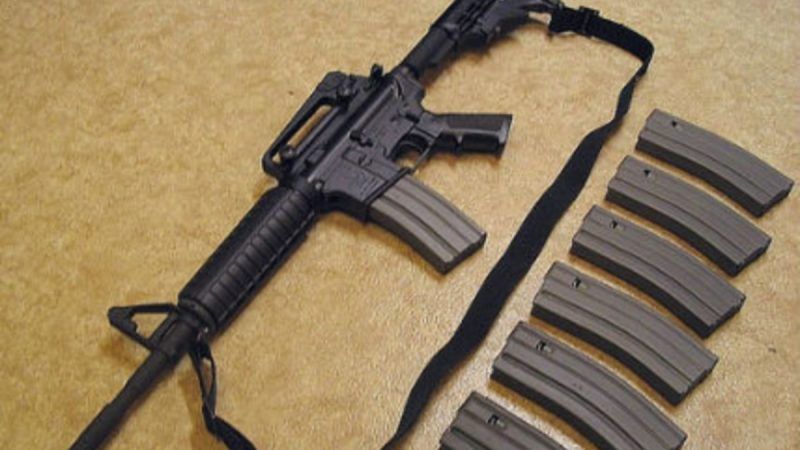SCOTUS Declines To Intervene in Lawsuit Blaming Gun Maker for Sandy Hook Massacre
The plaintiffs now have to prove that Remington's advertising was not only "unfair or deceptive" but "a proximate cause" of the attack.

The Supreme Court yesterday declined to intervene in a lawsuit that seeks to hold Remington Arms responsible for the 2012 shooting that killed 20 children and six adults at Sandy Hook Elementary School in Newtown, Connecticut. That decision means the plaintiffs—a survivor of the attack and relatives of nine people murdered at the school—can try to prove in state court that Remington violated the Connecticut Unfair Trade Practices Act (CUTPA) by marketing the Bushmaster XM15-E2S rifle used by the perpetrator, Adam Lanza, in a way that emphasized its "militaristic and assaultive qualities."
The CUTPA claim was the one cause of action left standing by the Connecticut Supreme Court last March, when it rejected a breathtakingly broad understanding of "negligent entrustment" that would make any supplier of military-style rifles liable for crimes committed with them. Under CUTPA, people can seek damages for injuries caused by "unfair methods of competition and unfair or deceptive acts or practices in the conduct of any trade or commerce."
Both theories were attempts to get around the Protection of Lawful Commerce in Arms Act (PLCAA), a 2005 federal law that generally protects gun manufacturers and distributors from liability for criminal uses of their products. The CUTPA claim is based on one of the exceptions made by the PLCAA, which allows lawsuits alleging that "a manufacturer or seller of a qualified product knowingly violated a State or Federal statute applicable to the sale or marketing of the product, and the violation was a proximate cause of the harm for which relief is sought."
The question presented to the U.S. Supreme Court, which it decided not to consider at this point, is whether that exception "encompasses alleged violations of broad, generally applicable state statutes" like CUTPA. Remington and briefs supporting its position argue that the phrase "statute applicable to the sale or marketing of the product" should be read to mean a firearm-specific law. They note that both examples mentioned in the PLCAA involve such laws, and they cite legislative history indicating that Congress intended to block lawsuits like this one.
"The lawsuits the PLCAA was enacted to address commonly included claims of negligent, unfair, or deceptive advertising, as well as claims under state unfair trade
practices statutes," Remington notes in its Supreme Court brief. "During the debates, Senator [Orrin] Hatch specifically criticized lawsuits 'citing deceptive marketing' and 'claim[ing] that sellers give the false impression that gun ownership enhances personal safety.'"
The plaintiffs, by contrast, argue that "statute applicable to the sale or marketing of the product" means any law that could be applied to firearms. Their interpretation was endorsed by the Connecticut Supreme Court, which disagreed on that point with two federal appeals courts.
In the 2009 case Ileto v. Glock, the U.S. Court of Appeals for the 9th Circuit concluded that "Congress had in mind…statutes that regulate manufacturing, importing, selling, marketing, and using firearms or that regulate the firearms industry," as opposed to "general tort theories that happened to have been codified by a given jurisdiction." The U.S. Court of Appeals for the 2nd Circuit allowed for a somewhat broader understanding of the exception in the 2008 case City of New York v. Beretta, saying it might include "a statute of general applicability" that does not explicitly mention firearms. But the court warned that reading "applicable" to mean "capable of being applied" would allow the exception to "swallow the statute."
In a brief urging the U.S. Supreme Court to hear this case, the National Rifle Association likewise warns that "the exception allowed by the Connecticut Supreme Court will swallow the [PLCAA] rule nationwide." It notes that "many other states" have laws similar or identical to CUTPA, "any one of which can now be used to circumvent national policy if the decision below is not corrected." The result, it says, will be precisely the sort of frivolous but expensive litigation that Congress saw as a threat to the Second Amendment.
"Exempting Respondents' lawsuit from PLCAA's immunity will result in a de facto ban on manufacturing or selling firearms, effectively preventing law-abiding Americans from purchasing constitutionally protected instruments," the NRA says. "This ban eventually will grow to encompass the sale of virtually every firearm in nearly every jurisdiction. Imposing what is effectively a company-killing level of liability cannot be squared with the basic policy judgments that underlie the Second Amendment. The right to acquire firearms is meaningless if the industry that provides firearms is litigated out of existence."
Then again, if this lawsuit ultimately fails, any flurry of litigation it inspires may be sparse and brief. The plaintiffs still have to prove that Remington's marketing was not only "unfair or deceptive" under CUTPA but also, per the PLCAA, "a proximate cause" of the Sandy Hook massacre. The Connecticut Supreme Court also applies a proximity requirement to CUTPA claims.
The National Shooting Sports Foundation, an industry group that asked the U.S. Supreme Court to take up this case, notes that the plaintiffs have not offered any evidence that Lanza or his mother, who bought the rifle he used, was "influenced in any way by any advertisement," let alone that advertising precipitated the mass shooting or made it deadlier. As the Connecticut Supreme Court itself observed while allowing the lawsuit to proceed, "proving such a causal link at trial may prove to be a Herculean task."


Show Comments (98)